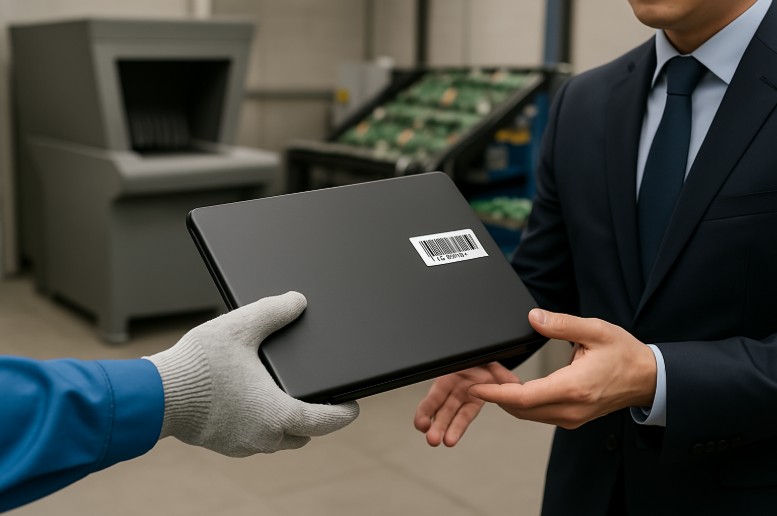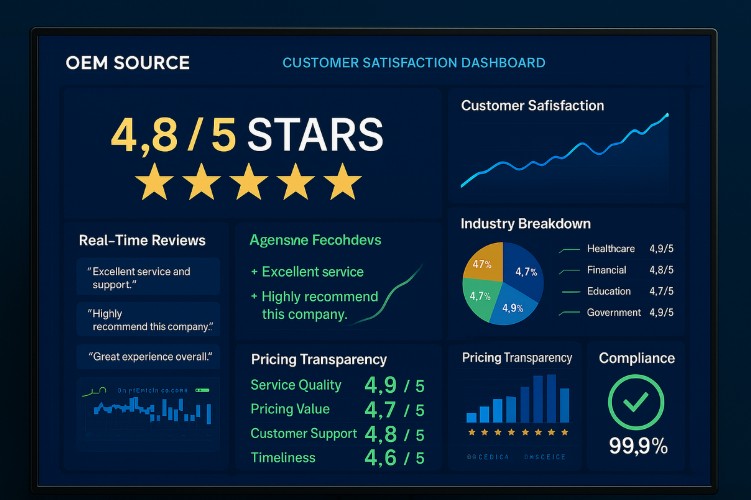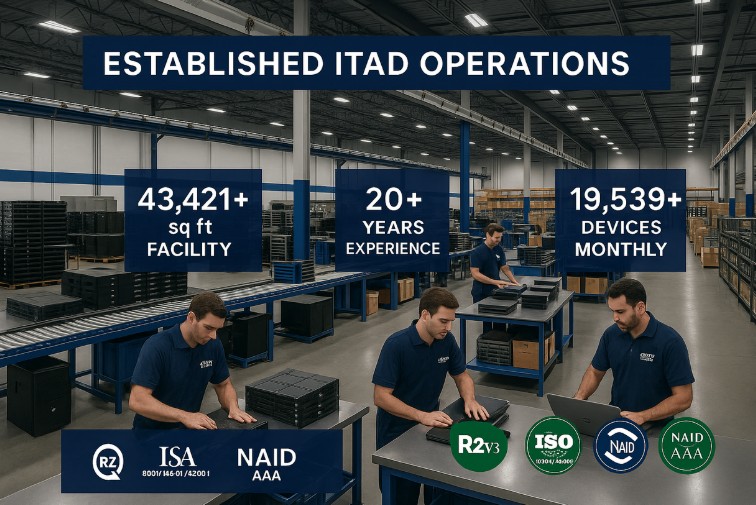In the contemporary business landscape, Information Technology (IT) assets serve as the backbone of daily operations, storing and processing vast quantities of sensitive data. From customer information and financial records to intellectual property and strategic plans, these assets contain information that is both valuable and vulnerable.
As IT equipment reaches the end of its lifecycle, IT Asset Disposition (ITAD) becomes critical. If mishandled, decommissioned devices can turn into significant liabilities, exposing organizations to data breaches, regulatory penalties, financial losses, and long-term brand damage. Proper ITAD is more than an operational task; it’s a core component of risk management and corporate governance.
The cornerstone of a secure and compliant ITAD process is a well-managed Chain of Custody (CoC). More than just a paper trail, a strong CoC documents every step of an asset’s journey from decommissioning through final destruction or recycling. This tracking system offers accountability, transparency, and control, ensuring sensitive data does not fall into the wrong hands and your organization remains compliant with legal and environmental standards.
In this article, we’ll examine how an effective Chain of Custody reduces key risks associated with IT asset disposition. You’ll learn what constitutes a strong CoC, the specific risks it helps to prevent, and the core elements require to implement one successfully. By understanding these principles, you’ll be better equipped to protect sensitive information, maintain compliance, and work confidently with ITAD providers who uphold the highest standards of security and documentation.
Defining Chain of Custody in the IT Asset Disposition Arena
In IT Asset Disposition (ITAD), the Chain of Custody (CoC) refers to the comprehensive, chronological, and unbroken documentation trail that tracks every step of an asset’s journey, from decommissioning to final destruction or remarketing. More than an administrative formality, a strong Chain of Custody is a crucial compliance and risk management tool, designed to ensure accountability, transparency, and control over assets that may contain sensitive data.
Each step represents a transfer of responsibility. If even one link is weak or unverified, the integrity of the entire process is compromised. A well-documented CoC provides evidence that an organization has taken proper steps to manage retired IT equipment, helping prevent data breaches, meet regulatory mandates, and avoid costly legal or financial exposure.
An effective Chain of Custody includes:
- Asset identification and inventorying: Recording serial numbers, asset tags, and detailed descriptions at the point of decommissioning.
- Documented movement and transfer: Logging who handled the asset, when, where, and for what purpose.
- Secure collection and transportation: Using vetted personnel in secure vehicles to maintain control during transit.
- Physical and logical security measures: Ensuring assets are protected from unauthorized access, theft, or tampering with secure storage areas, controlled access to processing facilities, and continuous surveillance.
- Verified data sanitization: Recording data sanitization methods (e.g., wiping, degaussing, physical destruction) and confirming successful data erasure.
- Final disposition records: Issuing Certificates of Destruction or Recycling to confirm regulatory compliance and proper handling.
This unbroken chain of documented control provides a clear, auditable history for each asset, demonstrating due diligence and responsible stewardship.
Why is this detailed tracking so crucial? Because in the absence of a strong CoC, IT assets become vulnerable black boxes once they leave an organization’s direct control. Without it, there is no verifiable way to confirm that sensitive data was properly destroyed, that assets weren’t diverted or stolen, or that e-waste was disposed of in an environmentally sound manner.
A well-maintained CoC is especially important for compliance with privacy laws like GDPR, HIPAA, CCPA, and industry-specific regulations. It reduces an organization’s risk of fines, legal liability, and lasting reputational harm. In the event of an audit or legal dispute, the CoC documentation serves as critical evidence of responsible ITAD practices.
Ultimately, Chain of Custody is more than just tracking assets. It’s a strategic framework for safeguarding data, meeting compliance obligations, and upholding an organization’s commitment to data security and corporate responsibility throughout the entire ITAD lifecycle.
The Perils of a Broken Chain: Key Risks in ITAD Without Strong CoC
A compromised or non-existent Chain of Custody (CoC) in the IT Asset Disposition (ITAD) process is far more than an administrative oversight—it’s a critical vulnerability When the tracking and verifiable control over retired assets breaks down, organizations face risks to data security, regulatory compliance, environmental responsibility, financial stability, and brand reputation. Below are the most pressing consequences of a broken or weak CoC.
Data Security Breaches: High-Risk Exposure
This is the most immediate—and often most damaging—consequence. Retired IT assets such as hard drives, SSDs, smartphones, and servers, often still contain sensitive and confidential information like:
- Personally Identifiable Information (PII)
- Protected Health Information (PHI)
- Financial data, intellectual property, and trade secrets
Without a secure CoC, these assets can be lost, stolen, or improperly accessed at any point during the disposition process—be it during on-site storage, transit, or at the vendor’s facility. If they are not properly sanitized or physically destroyed, and this process isn’t verifiably documented, the risk of a data breach becomes exceptionally high.
Example: The infamous Coca-Cola data breach, where stolen laptops containing PII of thousands of employees highlighted a CoC failure, serves as a stark reminder of this vulnerability.
Regulatory Compliance Failures: Costly and Avoidable
Businesses across sectors are governed by a complex set of data privacy regulations, including:
- General Data Protection Regulation (GDPR) in Europe
- Health Insurance Portability and Accountability Act (HIPAA) in U.S. healthcare
- California Consumer Privacy Act (CCPA)
- GLBA, PCI, DSS, and others
A broken CoC makes it nearly impossible to demonstrate due diligence and compliance. If an audit occurs or a data breach is traced back to improperly disposed assets, the lack of a verifiable CoC can result in crippling fines, legal action, and mandatory public disclosures.
Environmental Non-Compliance: Regulatory and Ethical Fallout
IT hardware often contains hazardous materials such as lead, mercury, cadmium, and flame retardants. Improper disposal of this e-waste can lead to significant environmental contamination, violating stringent environmental regulations like the Resource Conservation and Recovery Act (RCRA) in the U.S. or the WEEE Directive in Europe.
Without a CoC, there’s no guarantee that assets are being handled by certified recyclers. Improper handling can lead to:
- Assets dumped up in landfills
- Exports to regions with lax environmental laws
- Negative publicity and fines for environmental irresponsibility.
The robust CoC provides auditable proof that you’ve met environmental obligations.
Financial and Reputational Damage: A Double Hit
The financial impact of a CoC failure is twofold:
- Direct losses: Regulatory fines, legal fees, breach notification expenses, and credit monitoring
- Indirect losses: Loss of customer trust, damage to brand reputation, decline in stock value, and loss of competitive advantage
A highly publicized data breach or environmental scandal can take years to repair, if ever. Furthermore, if assets with residual value (e.g., for remarketing) are lost or stolen due to a poor CoC, the organization also suffers a direct financial loss from unrealized asset recovery. A strong CoC, therefore, is not just a security measure but also a vital component of protecting an organization’s financial health and public image.
Fortifying Defenses: How a Robust Chain of Custody Mitigates ITAD Risks
A meticulously maintained Chain of Custody acts as a powerful shield, proactively mitigating the diverse and significant risks inherent in the ITAD process. By establishing an unbroken line of accountability and verifiable control, a robust CoC transforms the potentially hazardous journey of an end-of-life IT asset into a secure, transparent, and defensible process. It provides specific protective mechanisms against data security threats, compliance failures, environmental irresponsibility, and financial or reputational damage.
Bolstering Data Security Through Verifiable Control
The primary defense offered by a strong CoC is against data breaches. From the moment an asset is decommissioned, a detailed CoC ensures data-bearing components are tracked and secured. This includes documenting:
- Who has access to the assets
- Where is it stored
- How is it transported?
- And, most crucially, how data is destroyed
Certified sanitization methods, such as NIST 800-88 standards compliant wiping, degaussing, or physical shredding, are clearly recorded and auditable. If an asset goes missing, the CoC can quickly identify the last known location and the responsible party, enabling fast investigation and containment.
By verifying destruction with Certificates of Data Destruction, the CoC also ensures that even if an asset were somehow compromised later, no recoverable data would remain, offering peace of mind and a strong defense against claims of negligence.
Ensuring Demonstrable Regulatory Compliance
Navigating the complex landscape of data privacy and environmental regulations—GDPR, HIPAA, CCPA, RCRA, WEEE, and more—is no easy task. A robust CoC serves as the operational backbone for compliance, turning legal mandates into verifiable, trackable steps.
Each CoC record—transfer logs, audit trails, Certificates of Destruction, and more—forms the evidentiary basis that regulators require during an audit or inquiry. For example, GDPR requires organizations to demonstrate technical and organizational measures for data protection. The detailed logs, transfer forms, audit trails, and destruction certificates generated by a CoC serve as this proof. In this way, a strong CoC only reduces the risk of penalties but reinforces a culture of compliance.
Promoting Environmental Responsibility and Accountability:
Improper disposal of electronic waste poses a severe threat to the environment. A strong CoC mitigates this risk by ensuring that all IT assets are tracked to certified and environmentally responsible recycling partners.
A well-documented CoC will verify that assets were not illegally dumped, exported to non-compliant facilities, or processed in a way that harms the environment. This includes:
- Verifying downstream vendors
- Ensuring legal processing
- Tracking the responsible handling of hazardous components
With these controls in place, organizations meet their corporate social responsibility (CSR) objectives and avoid the reputational damage associated with environmental negligence.
Safeguarding Financial Interests and Brand Reputation:
A broken CoC can cost millions. Data breaches, regulatory fees, and public scandals can inflict long-term financial and reputational damage.
Moreover, stakeholders—including customers, investors, and partners—are increasingly concerned about data privacy and environmental stewardship. A strong CoC shows that an organization takes these responsibilities seriously.
Additionally, for assets that have remarketing potential, the CoC ensures they are properly tracked, refurbished securely, and their value is accurately accounted for, preventing loss or theft that would otherwise result in direct financial loss. The transparency and control afforded by a strong CoC build trust and protect the organization’s bottom line and public image.
The Anatomy of Assurance: Essential Elements of an Effective ITAD Chain of Custody
An effective CoC in ITAD is not a monolithic entity but a carefully constructed framework of interconnected processes, documentation, and security measures. Each element plays a vital role in ensuring the integrity, transparency, and defensibility of the entire disposition lifecycle. Understanding these essential components allows organizations to build or select ITAD programs that genuinely protect their interests and meet strict compliance obligations. A truly robust CoC is characterized by its attention to detail across six key areas—from initial asset identification to final verification of destruction or recycling.
1. Comprehensive and Granular Documentation
At the heart of any CoC is thorough documentation. This begins with a detailed inventory of all assets designated for disposition, including serial numbers, asset tags, make, model, and, where applicable, original user or department. Standardized transfer forms must be used for every movement of assets, capturing signatures, dates, times, and locations of pickup and delivery. Secure, serialized seals on transport containers can provide an additional layer of tamper evidence.
All data destruction activities should be meticulously logged, noting the method used (e.g., wiping, degaussing, shredding), the applicable standard (e.g., NIST SP 800-88), the date, the technician responsible, and the serial numbers of the processed devices. Finally, Certificates of Data Destruction and/or Recycling must be issued for every asset, serving as formal attestation of secure and compliant processing. Documentation should be securely stored, easily retrievable for audits, and retained in accordance with regulatory and internal policy requirements.
2. Secure Logistics and Transportation
The physical movement of IT assets to an ITAD facility presents elevated risk. A strong CoC requires stringent transit controls, including the use of vetted, background-checked personnel. Assets should travel, GPS-tracked vehicles with defined direct routes.
For highly sensitive assets, dual custody or escorted transport may be warranted. Use of tamper-evident containers for smaller media or entire pallets ensures any unauthorized access is immediately identifiable. Upon arrival, TAD providers must document the condition of containers, verify seal integrity, and reconcile incoming items with the original transfer manifest.
3. Robust Asset Tracking Systems
Continuous, accurate tracking is foundational to any CoC. Leading ITAD providers employ barcode or RFID-based tracking systems that log asset status in real-time across every stage—from collection and intake to destruction or remarketing.
These systems not only enhance security by providing an immediate audit trail but also improve efficiency and accuracy in reporting. Many providers offer clients secure portal access to track their assets and download relevant CoC documentation.
4. Secure Processing Environment and Data Destruction Verification:
The ITAD facility itself must maintain high levels of physical and procedural security. This includes 24/7 surveillance (CCTV), restricted access, and clearly defined visitor policies.
Data destruction procedures must be clearly defined, consistently applied, and independently verifiable. This includes regular calibration and testing of data erasure software and degaussing equipment, as well as maintenance logs for shredders.
Verification of destruction success—via software-based verification for data wiping, magnetic force measurement for degaussing, or visual inspection of shredded particle size—should be included in the CoC documentation that media has been fully and irreversibly destroyed.
5. Stringent Personnel Controls and Training
Human error or malicious intent can undermine even the most sophisticated systems. Therefore, an effective CoC includes rigorous personnel controls. All employees with access to data-bearing devices—from drivers to processing technicians— should undergo thorough background checks and regular security awareness training. This training should cover data privacy obligations, CoC procedures, and incident response protocols.
Access to sensitive areas must follow the Principle of Least Privilege, ensuring that only authorized individuals handle sensitive devices. Clear accountability for each step in the process is essential.
6. Independent Audits and Certifications
While internal controls are vital, third-party validations provide the assurance organizations need. Certifications such as NAID AAA (National Association for Information Destruction) affirm a provider’s adherence to internationally recognized standards for data security, environmental stewardship, and chain-of-custody processes.
Regular external audits, combined with internal reviews, not only reinforce CoC integrity, but also reflect a provider’s commitment to continuous improvement and compliance transparency.
Selecting Your Guardian: Choosing an ITAD Partner with a Verifiable Chain of Custody
Entrusting your end-of-life IT assets to a third-party ITAD vendor is a decision that carries significant responsibility. The security of your sensitive data, your compliance posture, and your organization’s reputation often hinge on the diligence and integrity of your chosen partner. A cornerstone of this diligence is the ITAD vendor’s ability to establish, maintain, and verify an unbroken CoC. Selecting a partner with a demonstrably verifiable CoC is not just a best practice—it’s a critical safeguard for any organization serious about mitigating risk. This selection process requires careful evaluation, pointed questions, and a focus on tangible evidence of secure, consistent CoC protocols.
When evaluating potential ITAD partners, organizations should examine several key areas to determine the strength and reliability of their CoC. Firstly, ask about their documentation samples: transfer forms, asset tracking logs, data destruction certificates, and environmental disposal records. Are these documents detailed, standardized, and easily auditable? How long are these records retained, and how are they protected? A transparent vendor will readily provide documentation samples and walk you through their process.
Next, assess their physical and logistical security measures. This includes procedures for secure on-site collection, transport vehicles with GPS tracking and tamper-evident locks, and background-checked personnel. Be sure to ask about security at the processing facility—do they use access controls, surveillance, and secure storage areas? If feasible, conduct a site visit to validate their security practices firsthand.
Another crucial factor is the technology and systems they use for tracking. Does the ITAD vendor use automated systems like barcode or RFID scanning to provide real-time visibility? Can clients access a secure online portal to monitor asset status and download CoC documentation? Vendors who prioritize transparency and efficiency typically offer these capabilities.
Inquire about their data destruction methodologies and verification processes. Do they adhere to recognized standards like NIST SP 800-88? How do they verify successful data erasure or physical destruction for each device, and how is this verification documented within the CoC?
Also, ask about their personnel security practices. Do they conduct comprehensive background checks? Is there routine security training for all employees involved in ITAD handling? The human element is a critical link in the CoC, and a reputable vendor will invest in ensuring their staff are trustworthy and well-trained.
One of the most reliable indicators of a strong CoC is third-party certifications and audits. Certifications such as NAID AAA are especially meaningful—they specifically verify secure data destruction processes and require scheduled and unannounced audits of an ITAD vendor’s facilities, procedures, and documentation, providing a high level of assurance. This level of oversight ensures the vendor maintains compliance at all times, not just during initial reviews. Ask vendors to provide up-to-date documentation for their certifications, and verify the certification status directly with the certifying body when possible.
Finally, request client references and inquire specifically about their experiences with the vendor’s CoC, reporting consistency, and overall security. A provider confident in their processes will be happy to provide references from organizations with similar security and compliance needs.
By thoroughly evaluating these aspects, organizations can identify an ITAD partner that not only claims to offer a secure Chain of Custody—but can demonstrably prove it. In doing so, they gain a trusted partner capable of safeguarding their end-of-life assets with transparency, precision, and accountability.
Need help finding a verified ITAD partner you can trust?
OEM Source helps enterprises protect their data and reputation by connecting them with NAID AAA Certified ITAD providers who maintain rigorous CoC protocols. Whether you’re upgrading infrastructure or retiring legacy equipment, we’ll help you navigate secure, compliant asset disposition from start to finish.
Contact OEM Source to get started.
Frequently Asked Questions about Chain of Custody in ITAD
What exactly is Chain of Custody (CoC) in the context of IT Asset Disposition (ITAD)?
Chain of Custody in ITAD refers to the complete, chronological, and verifiable documentation trail that tracks every IT asset from the moment it is decommissioned by an organization until its final data destruction and physical disposal or remarketing. It’s a security and compliance protocol that ensures accountability, security, and transparency by recording who handled the asset, when, where, and what actions were performed on it (e.g., data wiping, shredding, recycling). It’s more than just a paper trail—it’s a system of control.
Why is a strong Chain of Custody so critical for businesses during ITAD?
A strong CoC mitigates major risks such as data breaches from improperly handled sensitive information on old devices, non-compliance with privacy regulations (e.g., GDPR, HIPAA, CCPA), environmental non-compliance from improper e-waste disposal, and financial or reputational damage resulting from any of these failures. It provides proof of due diligence and responsible asset management, especially in the event of audits or legal inquiries.
What are the key components of an effective Chain of Custody?
Key components include:
- Detailed initial asset inventory (serial numbers, descriptions)
- Standardized transfer forms for every movement
- Secure logistics using vetted personnel and GPS-tracked vehicles
- Asset tracking systems (e.g., barcode or RFID scanning)
- Secure processing environments with controlled access and surveillance;
- Verified data destruction methods
- Personnel controls, including background checks and training
- Certificates of Data Destruction and/or Recycling for each asset
How does Chain of Custody help prevent data breaches?
CoC ensures continuous oversight and control over data-bearing assets. It mandates secure handling, transportation, and storage, and most importantly, it requires verifiable data destruction (e.g., physical destruction, data wiping). If an asset were to go missing, the CoC would help identify the breach point. The documented proof of data destruction ensures that even if an asset is later accessed, no sensitive data is recoverable.
What kind of documentation should I expect from an ITAD provider as part of their Chain of Custody?
You should expect comprehensive documentation, including:
- Initial inventory list
- Signed transfer receipts
- Serialized logs for asset movement;
- Data sanitization records per device
- Certificates of Data Destruction and/or Recycling
All documentation should be auditable and securely maintained.
How can I verify if an ITAD vendor has a truly reliable Chain of Custody?
Ask detailed questions about their CoC processes, requesting sample documentation, and inquiring about their security measures (physical, transport, and facility). Look for third-party certifications like NAID AAA, which specifically audits data destruction and CoC practices. Don’t hesitate to ask for client references and conduct site visits if possible.
What role do employee background checks and training play in maintaining a secure Chain of Custody?
Personnel play a critical role in CoC. Background checks help reduce insider threats, while regular training ensures employees follow proper security protocols, CoC procedures, and privacy laws. This helps minimize both accidental errors and malicious behavior.
If my company handles ITAD internally, do we still need to worry about Chain of Custody?
Absolutely. Whether ITAD is handled internally or outsourced, the risks and compliance obligations remain the same. Internal ITAD processes must also implement a robust Chain of Custody to ensure data security, meet regulatory requirements, and provide an auditable trail. This includes all the key elements: documentation, secure handling, verified data destruction, and responsible disposal.
How does Chain of Custody relate to environmental responsibility in ITAD?
CoC ensures that assets are tracked to certified, environmentally responsible recycling facilities. It documents that e-waste is not illegally dumped or improperly processed, which could harm the environment and violate regulations like RCRA or WEEE. The CoC provides proof that your organization is adhering to sustainable and ethical e-waste disposal practices.
Can a good Chain of Custody help in recovering value from old IT assets?
Yes. A secure CoC allows for secure data wiping and proper tracking of assets eligible for resale or refurbishment.. This maximized any potential financial return from their remarketing, while still ensuring data security throughout.





